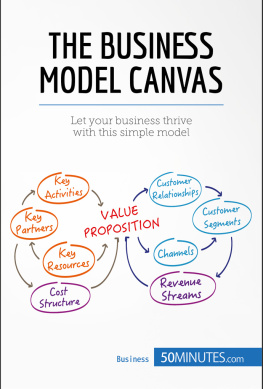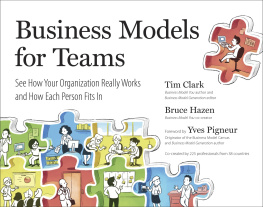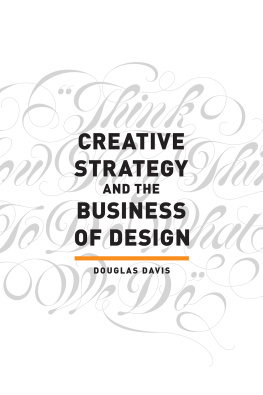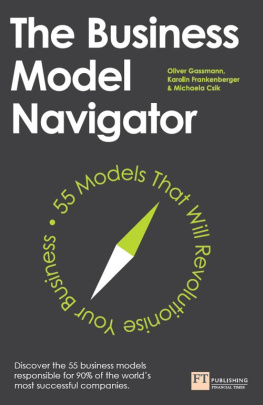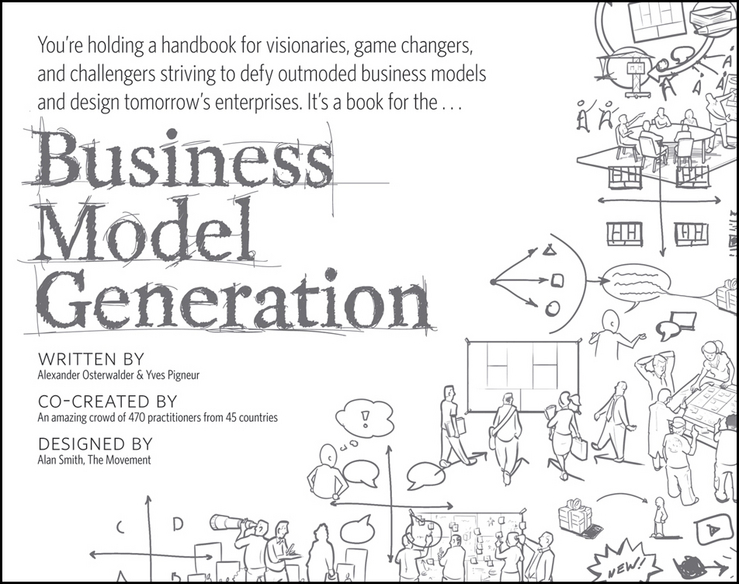Copyright 2010 by Alexander Osterwalder and Yves Pigneur. All rights reserved.
Published by John Wiley & Sons, Inc., Hoboken, New Jersey.
Published simultaneously in Canada.
No part of this publication may be reproduced, stored in a retrieval system, or transmitted in any form or by any means, electronic, mechanical, photocopying, recording, scanning, or otherwise, except as permitted under Section 107 or 108 of the 1976 United States Copyright Act, without either the prior written permission of the Publisher, or authorization through payment of the appropriate per-copy fee to the Copyright Clearance Center, Inc., 222 Rosewood Drive, Danvers, MA 01923, (978) 750-8400, fax (978) 646-8600, or on the web at www.copyright.com. Requests to the Publisher for permission should be addressed to the Permissions Department, John Wiley & Sons, Inc., 111 River Street, Hoboken, NJ 07030, (201) 748-6011, fax (201) 748-6008, or online at http://www.wiley.com/go/permissions.
Limit of Liability/Disclaimer of Warranty: While the publisher and author have used their best efforts in preparing this book, they make no representations or warranties with respect to the accuracy or completeness of the contents of this book and specifically disclaim any implied warranties of merchantability or fitness for a particular purpose. No warranty may be created or extended by sales representatives or written sales materials. The advice and strategies contained herein may not be suitable for your situation. You should consult with a professional where appropriate. Neither the publisher nor author shall be liable for any loss of profit or any other commercial damages, including but not limited to special, incidental, consequential, or other damages.
For general information on our other products and services or for technical support, please contact our Customer Care Department within the United States at (800) 762-2974, outside the United States at (317) 572-3993 or fax (317) 572-4002.
Wiley also publishes its books in a variety of electronic formats. Some content that appears in print may not be available in electronic books. For more information about Wiley products, visit our web site at www.wiley.com.
ISBN: 978-0470-87641-1
Printed in the United States of America
10 9 8 7 6 5 4 3 2 1
Preface
Are you an entrepreneurial spirit?
yes _______ no _______
Are you constantly thinking about how to create value and build new businesses, or how to improve or transform your organization?
yes _______ no _______
Are you trying to find innovative ways of doing business to replace old, outdated ones?
yes _______ no _______
If youve answered yes to any of these questions, welcome to our group!
Youre holding a handbook for visionaries, game changers, and challengers striving to defy outmoded business models and design tomorrows enterprises. Its a book for the business model generation.
Today countless innovative business models are emerging. Entirely new industries are forming as old ones crumble. Upstarts are challenging the old guard, some of whom are struggling feverishly to reinvent themselves.
How do you imagine your organizations business model might look two, five, or ten years from now? Will you be among the dominant players? Will you face competitors brandishing formidable new business models?
This book will give you deep insight into the nature of business models. It describes traditional and bleeding-edge models and their dynamics, innovation techniques, how to position your model within an intensely competitive landscape, and how to lead the redesign of your own organizations business model.
Certainly youve noticed that this is not the typical strategy or management book. We designed it to convey the essentials of what you need to know, quickly, simply, and in a visual format. Examples are presented pictorially and the content is complemented with exercises and workshop scenarios you can use immediately. Rather than writing a conventional book about business model innovation, weve tried to design a practical guide for visionaries, game changers, and challengers eager to design or reinvent business models. Weve also worked hard to create a beautiful book to enhance the pleasure of your consumption. We hope you enjoy using it as much as weve enjoyed creating it.
An online community complements this book (and was integral to its creation, as you will discover later). Since business model innovation is a rapidly evolving field, you may want to go beyond the essentials in Business Model Generation and discover new tools online. Please consider joining our worldwide community of business practitioners and researchers who have co-created this book. On the Hub you can participate in discussions about business models, learn from others insights, and try out new tools provided by the authors. Visit the Business Model Hub at www.BusinessModelGeneration.com/hub.
Business model innovation is hardly new. When the founders of Diners Club introduced the credit card in 1950, they were practicing business model innovation. The same goes for Xerox, when it introduced photocopier leasing and the per-copy payment system in 1959. In fact, we might trace business model innovation all the way back to the fifteenth century, when Johannes Gutenberg sought applications for the mechanical printing device he had invented.
But the scale and speed at which innovative business models are transforming industry landscapes today is unprecedented. For entrepreneurs, executives, consultants, and academics, it is high time to understand the impact of this extraordinary evolution. Now is the time to understand and to methodically address the challenge of business model innovation.
Ultimately, business model innovation is about creating value, for companies, customers, and society. It is about replacing outdated models. With its iPod digital media player and iTunes.com online store, Apple created an innovative new business model that transformed the company into the dominant force in online music. Skype brought us dirt-cheap global calling rates and free Skype-to-Skype calls with an innovative business model built on so-called peer-to-peer technology. It is now the worlds largest carrier of international voice traffic. Zipcar frees city dwellers from automobile ownership by offering hourly or daily on-demand car rentals under a fee-based membership system. Its a business model response to emerging user needs and pressing environmental concerns. Grameen Bank is helping alleviate poverty through an innovative business model that popularized microlending to the poor.
But how can we systematically invent, design, and implement these powerful new business models? How can we question, challenge, and transform old, outmoded ones? How can we turn visionary ideas into game-changing business models that challenge the establishmentor rejuvenate it if we ourselves are the incumbents? Business Model Generation aims to give you the answers.
Since practicing is better than preaching, we adopted a new model for writing this book. Four hundred and seventy members of the Business Model Innovation Hub contributed cases, examples, and critical comments to the manuscriptand we took their feedback to heart. Read more about our experience in the final chapter of Business Model Generation.
Seven Faces of
Business Model Innovation


